More Renfrew sewing progress! I started my assembly-line cutting with the solid knits, because they’re easier than stripes. The fabric I’m using is a 95% cotton, 5% spandex jersey knit in a medium weight. It’s heavier than a standard tee shirt but not anywhere near as thick as yoga pants. (It sure is hard to describe fabric weight in words!)
A jersey knit like this has a wrong side, and a right side. The right side has tiny little vertical lines almost like ‘ribs’ on the surface, while the wrong side has no vertical lines and might look like there’s a horizontal texture to it. I hope it’s somewhat visible in this photo!
Can you see the slight vertical ‘stripe’ texture on the right side? The right side is on the bottom of the photo, the wrong side is on the top.
Another way to tell the right side of the cotton is the selvedges curl towards the wrong side. If you turn over the edge, the wrong side has the curled edge that can be unrolled. In the photo below, the wrong sides are on the inside.
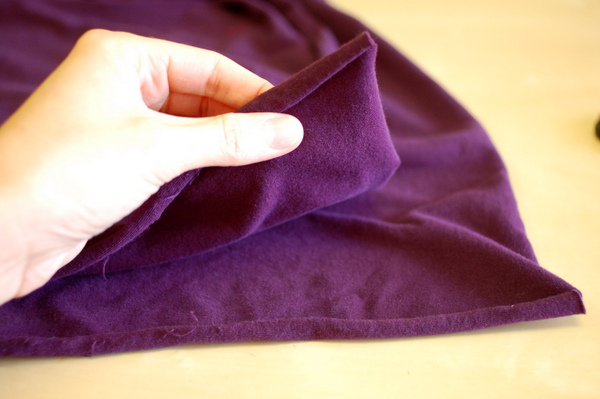
Have you ever had a knit tee shirt where the sideseams twisted on you? Fresh from the laundry (or the store), the shirt would be well-behaved with sideseams at the side. Then as you wear it, one of the sideseams starts working its way towards the centre of your shirt. Why does that happen?
Most likely, if it’s not an intentional design detail, it means the fabric was cut off-grain. Remember those little vertical stripes we saw on the right side of the fabric? If your garment is cut with those ribs not completely straight, the sideseams will twist. That’s the wonderful thing about sewing our own clothing – we can fix these things!
Here’s how to ensure your knit fabric is cut on the grain:
First, figure out how we need to be folding out fabric to cut it out. We’re about to spend a bit of time folding our fabric, it’s a real pain if you find out it was supposed to be folded differently after all that work!
Look at the fabric cutting diagram and find the one for the view you’re making. Sometimes there will be one fold, sometimes there will be two folds with the selvedges folded into the middle. Or sometimes, there’s both types of cutting layouts for a single view.
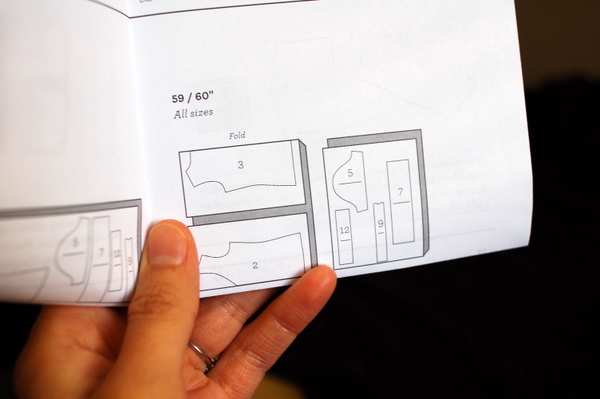
Now, we’ll fold the fabric. This is going to be tedious but I feel it’s worth it to ensure your shirt is cut on-grain.
Fold your fabric according to the diagram. I’m folding two folds with the selvedges in the centre, like the left diagram in the photo above. Fold it loosely, this is just a guide to start correcting the foldline. (I hope you can see where the edge is, the dark purple is hard to photograph!)
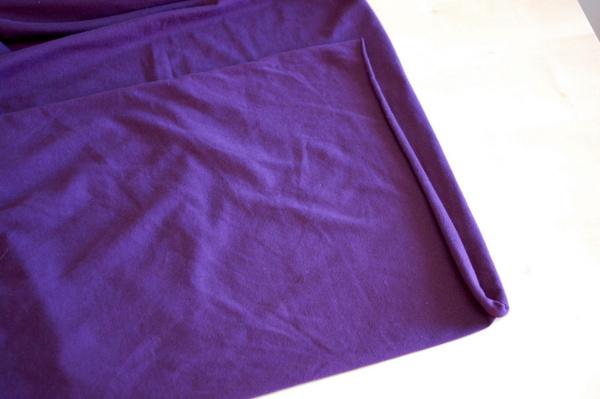
Now, we’ll work on that fold. This next step was again, pretty hard to photograph.
What we want to do is line up those little, vertical striped rib lines along the fold. Here, this photo turned out much better!
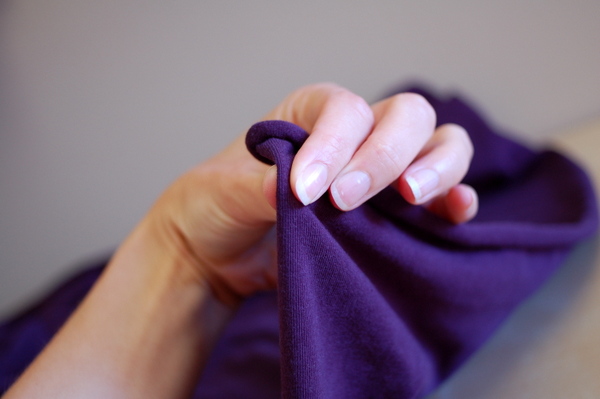
You can see that I’m pinching the fold along the ribbed, vertical lines, making sure that one or two lines are along the fold line.
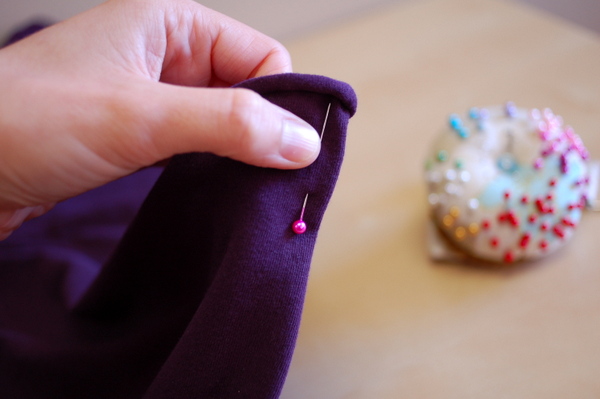
Pin along the fold line to keep the ribs on the fold.
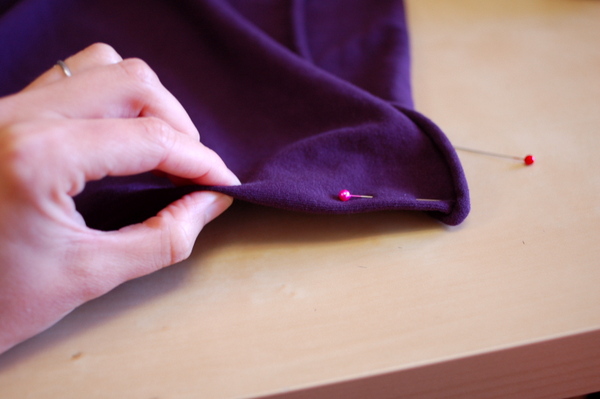
Keep on pinning along the fold line until the entire fold line is pinned. Now when you smooth out the fabric away from the fold, the fabric will stay on grain. If you have two folds in your fabric, repeat with the second fold. (Don’t forget to remove the fold pins as you cut your pattern pieces!)
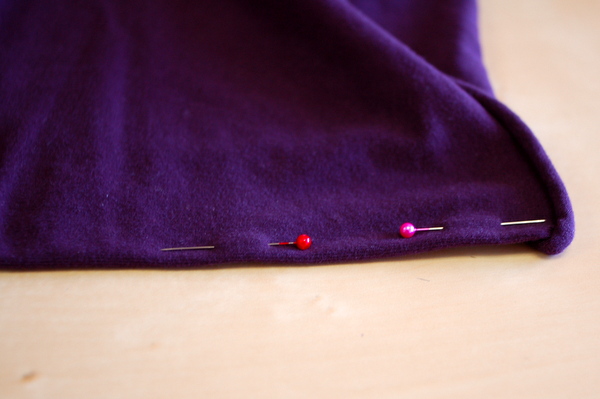
This is a very thorough method (and perhaps a little fiddly) to keeping your knit fabric aligned and on-grain when you cut it. It might seem like an awful lot of work for such a simple project! I’m a particular person and I’d rather spend the extra time now, than end up with a garment that frustrates me later by twisting. You might not want to spend the time fiddling with the fold and pinning it along the ribbed lines. Do you have to? Of course not! Depending on your fabric, you may be able to fold it and have the straight of grain line up perfectly, no pinning required.
This is actually one thing that makes cutting striped fabric easier – if the stripes are knit into the fabric and not printed, the extra work that it takes to line up the stripes also takes care of the grain at the same time.
Get the pattern here.

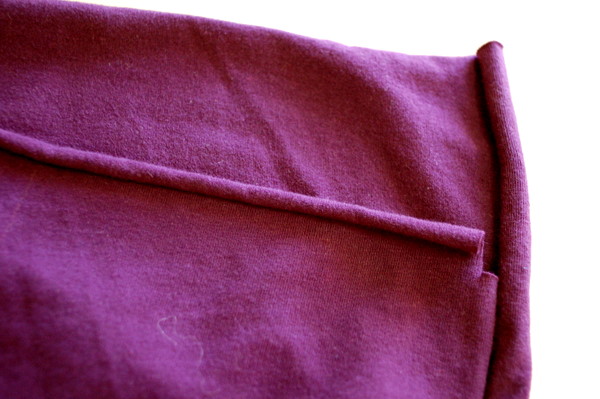
This is a tricky thing for sure. When I’m cutting a knit pattern, I cut each piece individually, because I find the underneath piece can end up off-grain. Does that make sense? For example, I will cut each sleeve separately, making sure to line up the grain line properly. It takes longer than simply folding the fabric and cutting both pieces at once, but then you know you won’t end up having to re-cut a piece later (and if you don’t have enough fabric, you may end up living with a twisty sleeve or whatever!).
That makes sense! I smoothed out the underneath piece a few times before it would lie flat. Knits can cling to each other and make it hard to keep both layers smooth.
Yep, and if the stripes don’t line up, or rather: you don’t get a nice folding line once you’ve lined up the stripes, chances are that the fabric wasn’t cut correctly…
Yup, or the stripes were printed on top of the surface crookedly! That’s the worst because then you’re not sure what to line up: the grain, or the stripes?
I too would rather spend the extra time making sure everything is cut properly because I think it can make a huge difference to the final garment and you can avoid so many headaches along the way! I make sure knits are on grain in a similar way – instead of pins, I thread trace a line of basting down one of the ribs (wherever I’m going to place the fold). I’d never thought of doing it your way! I guess you must have wrong sides together so that you can see the ribs as you pin the fold, right?
Exactly! Wrong sides are together so you can see the ribs. On the inside (wrong side) there’s no indicators of the grain. Thread-tracing sounds like a great idea too! (Easily visible and great for lining up grain arrows when you’re not working with the fold.)
I’m also cutting out some Renfrew tops assembly line style. I’m going to have a Renfrew in almost every colour when I’m finished.
I’m a more experienced knitter than a sewer, and I always thought that the right side (with the vertical lines) was the side the fabric curled towards. Does that change with a jersey knit?
I love your patterns and I’m looking forward to more tips on the Renfrew.
I also thought the edge curled toward the right side. Do different knits act differently?
Ok, you guys are right, it’s not totally clear. The edge that rolls towards the wrong side is the selvedge – but the cut horizontal edge rolls towards the right side.
The very first photo shows this – the top, cut edges are rolling to the right side, the side, selvedge edges are rolling to the back. (And some selvedges won’t roll very much at all.)
Thanks for pointing this out!
i have no idea if this is the “right” way but usually i just make a small cut and tear across the width of the fabric to get the grainline. it works fine on jersey knits and ity. i’m guessing it wouldn’t work as well on interlock or double knits but i haven’t tried it.
I haven’t been able to tear any of my knit fabrics without stretching the edge way out of shape! That’s what I do on most of my woven fabrics, anything that will tear, but never on knits. I wouldn’t trust that the fold was on-grain even if I was able to straighten the edges. It may be just that I prefer a certain type of knit fabric and that kind doesn’t tear. (Now I’m curious to see if any of my knits will tear – I feel like it would distort the edge a lot if I were to try!)
Hi, Tasia,
I’ve used that method numerous times but found that the underside of the fabric is still, no matter what I do, slightly off. Maybe not enough to be off-grain, but enough to be noticeably asymmetric. I’ve tried flipping the piece over while it is still pinned, unpinning, smoothing out the bottom-turned-top layer (it is always slightly larger than the other side) and trimming, which helps. For my next attempt, I’m going to duplicate the pattern piece (trace it) so that I have a whole piece and just cut a single layer.
My plan is to draw a grain line down the center of the piece and pin-trace a several ribs just as you show above (maybe divide the shirt width into quarters, if that makes sense), lay down the fabric and make sure each of the ribs is in a straight line (no distortion), and match the center pattern line to a pinned rib, and then cut the single layer. Kind of a PITA for a t-shirt, but it appeals to the OCD in me. :)
That is a good idea – tracing the pattern piece and duplicating it to be cut on a single layer instead of the fold! It appeals to the OCD in me, too.
If it is a “fancy” knit fabric, I thread trace every 4-6″ inches and cut in single layers (make sure you mirror your pattern). the PITA is so worth the effort on nicer fabrics, not to mention shifting knits are completely unflattering.
Thanks for the feedback! You know, I thought I was being overly picky with my method, it’s nice to hear that many of you make the same (or better!) efforts at the cutting stage with knits to get a quality garment.
Check to see if there is a Macro setting on your camera. You can use this for shooting a clear close up shot with better detail. =)
There’s a ‘flower’ setting for close-ups, I might try that! I think it gets confused when I get too close to the thing I’m photographing. Thanks for the suggestion!
I’ve bought the Renfrew pattern when it first came out but haven’t got it out of the packet because of issues like this. I recently bought 2 different fabrics intending to make it at last and then you came along and said you were making some and there would be extra tips so I’m really grateful for the timing and that you are spending time helping us. I’m thinking I will trace the pattern so that I can cut the pattern out on a single layer, this is something I’ve found a lot easier to do with a woven so I’m going to stick with that approach. I look forward to the next installment in the Renfrew saga!
Ah, you’re welcome! I’m glad the tips are helpful. It sounds like a lot of people bought the pattern but have been sitting on it, waiting for a little more help before jumping in. You’re not the only one!
I agree that this little extra steps in the process might be a bit fiddly, but much better than wasting time overall making a garment that is wearable but annoying, or just plain unwearable.
Totally agree. There’s no point making a garment that will just annoy you! (Even if no one else would notice the problem.)
Funny, I am always called the “nitpicky one” (knitpicky one? ;-) ) at sewing class, because I spend sooo much time aligning the pattern pieces with the fabric! Glad to see I am not so weird then after all :-)
Just like Suzanne and June, I cut each pattern piece individually, when we’re talking knits. And pieces that could be cut along a fold – I simply mirror those on a single layer of fabric and cut them in one layer as well. Because no matter how carefully I pin and put pattern weights on top, the lower layer is always somewhat askew.
The true ‘horror’ arrives when you have a striped knit – say, sailor style – and the stripes are not perpendicular to the grainline… And pulling opposite corners to get the grainline in a 90° angle with the stripes only works for a minute or so, after that, the fabric crawls back to where it was before… If someone knows of a solution for this dilemma, I am all ears!
Not weird at all! It was so nice to hear that many other people are just as cautious with their cutting.
I hate stripes that are off-grain! Grrr. I don’t have a solution, except to leave those fabrics alone and work on something more satisfying. Avoid them if you can. :)
Great post Tasia. Those of us who have sewn with knits frequently find that being “Picky” is very important. A twisted seam, a rippled hem, or tension in all the wrong places makes for a wadder if there ever was one. Typical off grain situations. I purchased two long sleeved T’s (I call them liners because I wear them under sweaters because of a wool sensitivity) High end store, supposedly high quality jersey, they each have a twist at the bust line. Just where I need some tension!!! I prefer to cut single layer because it is just easier for me. Your method looks like it would increase my accuracy when cutting double. I will give it a try. Thanks.
So frustrating! High end garments should be high end quality. You’re not alone in the single-layer cutting, I think it depends on the fabric. If it’s going to slip and slide then single is better. If, once you’ve got it folded where you want it, it stays put, then folded cutting is fine. (That’s my experience anyways!)
Such a simple tip but well worth the extra effort. I so would not have thought of this. Am starting my new Renfrew this week so will take this on board. Yippee!
Yay! Glad it was useful. I have plenty more Renfrew posts coming up over the next few weeks that might help as well. Happy sewing!
i hate when i get a pattern thinking it’s for cottons and it’s sized for stretch knits only!! i’m not a big fan because i can only ever find solids, never any really cute prints.
I know what you mean about finding cute prints…. most of the prints I find are too juvenile. But, I’m going to try my first Renfrew on a solid and work out the fitting bugs, and maybe find some nicer knits online.
This is really helpful, Tasia. I’d always wondered why a couple of bought t-shirts twisted like that. Mystery solved :-) When I made my first renfrew, I took ages to try and get it on grain. I also followed the columns of knit stitches but I like your idea of pinning (I ended up drawing a line in chalk along one of them which would be my fold line; I think the pins are a better idea). I still ended up cutting sleeves separately, to make sure they were both on grain. Thanks for the tips!
Hi! Thanks for this great set of posts. Sewing knits is still a bit scary to me, but I’m getting there. Where do you find your knits? I have to order them online, so I’d love to know if you have suggestions for brands/websites.
Hi! I’ve been buying a lot of fabric from Telio, a fabric wholesaler, because they have really great knits and I can touch the samples before buying. They sell to a bunch of fabric stores including Mood Fabrics and Hart’s Fabric, both of which have online stores. I also find good knits at my local store, Fabricana here in Richmond BC, and I’ve seen some very nice knits for sale at Gorgeous Fabrics with good descriptions of what they feel like.
Many places will let you order swatches, so you can touch and feel the fabric before buying a lot of it. Hope this helps!
Ok, what does PITA stand for???? Am I missing something?
PITA = pain in the a$$
PITA = pain in the ass! :)
Oh my! :)
I too have been sitting on the Renfrew pattern and a couple of knit fabrics wondering how to get started! Thanks for the tips! I think I will duplicate the pattern first and cut single layer just to be sure! PS. What is OCD?
OCD – obsessive compulsive disorder, in our case it’s probably not a real disorder, just the need to have everything ‘just so’ and be extra particular!
Thank you for this!! I absolutely HATE rtw side seams that “travel” – I always thought it was because my body was lopsided LOL, now I know it’s because they were cheaply made!! I’m definitely going to spend the extra time doing this when I make my first Renfrew!
As a side note, I find it’s actually easier to tell the right/wrong side of a knit than a woven in some cases, because the right side has those distinct lines whereas the wrong side kind of looks almost ‘nubbly’ up close LOL
These posts are super helpful,thanks so much Tasia!
Ok, Tasia, you’ve got to be stinking kidding me!!!!!!!!!! LOL!!!! I am trying to line up my teeny weenie microscopic ribs, BUT I can barely see them! Ha Ha. I have even tried using a magnifying glass (maybe mine isn’t very powerful) and I can only follow the rib for an extremely short distance much less well enough to put the magnifying glass down long enough to then put the pin in. Anybody out there have any suggestions on how someone with 50 year old eyes can accomplish this daunting task?
Drugstore reading glasses!
Okay, I get this and always try my best to keep knit fabrics on grain as I cut out pattern pieces. It isn’t as easy as wovens, of course, but I have an additional question. I am cutting out a knit top with cotton jersey and misread a neckline band and only cut out two when the pattern was labeled cut 4. I’m out of fabric and in order to get the additional two neckbands, I will have to cut them off grain. Before I do this I wanted to ask what the result would be on the finished garment? I was thinking of trying to find a coordinating knit for the bands to solve the problem. Anyone have the answer to this dilemma?
Hi, I`ve just started learning how to sew. And cutting the fabric is hard for me.
I dont how to cut it. Its like my mind is blocked and I can not see a solution :/
I have 5m long, 180ish cm wide fabric which I want to cut in 3. You just cut at the 60cm mark. No brainier, right?
The thing is, the fabric ends are uneven. They are all wavy looking form previous cutting.
Any advice on how to do it? Maybe a link to some older post where you explained that (I`ve looked but couldnt find)?
TIA
Dache